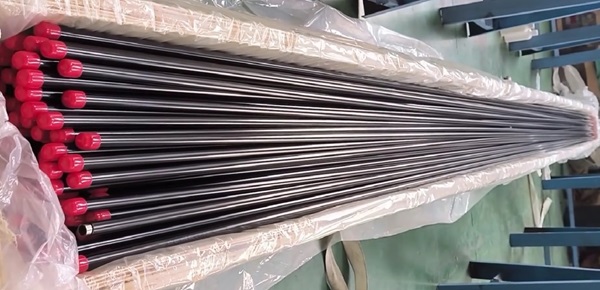Categories
- Technical & Application (25)
- Steel Tubing (20)
- Alloy Tubing (8)
PVC coated stainless steel tubing, also known as stainless steel tubing with PVC coating, is generally a hollow product of round cross section made of stainless steel with an outer coating of PVC (polyvinyl chloride). The core tubing, either seamless or welded, is usually made of austenitic stainless steels in accordance with ASTM A269. It is primarily used for general corrosion-resisting and low- or high-temperature service. A layer of polyvinyl chloride adheres to the exterior surface of the stainless steel tubing properly, providing full coverage and desired protection.
The stainless steel tubing, which is made in accordance with ASTM A269, shall be made from a series of austenitic stainless steels including TP201, TP201LN, TP304/304L, TP316/316L, TP304LN, TP321, TP347, TP348, TP316LN, S31655, TP317, S31730, XM-10, XM-11, XM-15, XM-19, XM-29, S31254, S31725, S31726, S31727, S32053, S30600, S32654, S34565, S35045, N08367, N08926, N08904. Among all grades, TP304/304L and TP316/316L are the most widely used grades. The core tubing is made from austenitic stainless steels, which are renowned for its high strength, ductility and durability. Most important, these stainless steels offer excellent resistance to rust, oxidation, and various chemicals in a wide range of demanding applications and harsh environments.

ASTM A269 TP316L seamless tubing with black PVC coating, supplied to Saudi Arabia.
The sizes of the core stainless steel tubing are usually 1/4″ [6.4 mm] in inside diameter and larger, and 1″ [25.4 mm] in outside diameter and smaller. The wall thicknesses of the tubing is usually 0.020″ [0.51 mm] in nominal wall thickness and heavier, but no greater than 0.120″ [3.05 mm]. Some frequently used wall thicknesses are specified by B.W.G numbers: (1)No.20: 0.035″, (2)No.19: 0.042″, (3)No.18: 0.049″, (4)No.17: 0.058″, (5)No.16: 0.065″, (6)No.15: 0.072″, (7)No.14: 0.083″, (8)No.13: 0.095″, (9)No.12: 0.109″, (10)No.11: 0.120″.
PVC (Polyvinyl Chloride) is a type of plastic known for its durability, chemical resistance, and flexibility. The PVC coating on stainless steel tubing offers multiple benefits: it provides mechanical protection against physical damage such as abrasion and scratches, enhances corrosion resistance by shielding the stainless steel from environmental factors like moisture and corrosive chemicals, acts as an electrical insulator to prevent conductivity, and can be colored for aesthetic purposes or to identify different piping systems.

The PVC coated stainless steel 316L tubing, plastic-capped at each end.
There are several methods for applying PVC coating to stainless steel tubing: Extrusion Coating involves heating PVC and extruding it over the tube, providing a uniform and high-speed coating but is limited in thickness and requires specialized equipment. Dip Coating entails pre-heating the tube, dipping it into PVC powder, and then reheating to achieve thicker coatings, suitable for small batches but requires precise temperature control. Electrostatic Coating uses charged PVC powder applied electrostatically and heated to form a smooth, high-quality coating with precise thickness control, though it demands specialized equipment and can be difficult for small diameters. Liquid PVC Coating involves dipping or spraying the tube with liquid PVC, which is then cured; it is simple and cost-effective but may not achieve as durable or uniform a coating compared to other methods.

Marking of PVC coated stainless steel tubes: ASTM A269 TP316L, (OD)12.7mm x (WT)1.24mm x (L) 6000mm.
PVC-coated stainless steel tubing is widely used across various sectors due to its enhanced properties. It is ideal for chemical processing where it resists corrosive chemicals, in marine environments for protection against saltwater corrosion, and in the food and beverage industry for maintaining hygiene and durability. The tubing also suits construction and infrastructure projects for its strength and environmental resistance, electrical and telecommunications applications where it serves as an insulator, and medical and laboratory settings for its chemical resistance and ease of sterilization. The combination of stainless steel’s durability and the PVC coating’s protective features ensures reliable performance in challenging conditions.